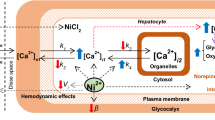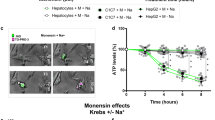Abstract
The liver is the primary organ involved in manganese (Mn) homeostasis. The human hepato-carcinoma cell line, Hep-G2, shows many liver specific functions. Consequently, Hep-G2 cells were investigated as a possible model of hepatic metabolism of Mn. Initial experiments showed that the concentration of Mn in the diet, or culture medium, similarly affected the retention of Mn by isolated rat hepatocytes and Hep-G2 cells. Manganese uptake by Hep-G2 cells suggested that uptake was followed by release from the cell. Uptake was saturable and half-maximal at 2.0 μmol Mn/L, and was inhibited by iodoacetate, vanadate, cold, and bepridil. The cations Fe2+, Cu2+, Ni2+, Cd2+, and Zn2+ decreased Mn uptake. Uptake was dependent on Calcium (Ca) concentration in a manner that resembled saturation kinetics. Cells that were pulsed with54Mn and then placed into nonradioactive medium quickly released a large portion of their internalized Mn. Release of internalized Mn could be inhibited by low temperature, nocodozole, quinacrine and sodium azide. These data show that Hep-G2 cells are a potentially good model of hepatic Mn metabolism. Mn is taken up by a facilitated process that may be related to Ca uptake. Release apparently is an active, controlled process, that may involve microtubules and lysosomes.
Similar content being viewed by others
References
L. Hurley and C. Keen, Manganese, in:Trace Elements in Human and Animal Nutrition, vol. 5, W. Mertz, ed., Academic, San Diego, CA, pp. 185–224 (1987).
D. Lee and P. Johnson,54Mn absorption and excretion in rats fed soy protein and casein diets (42852),Proc. Soc. Exp. Biol. Med. 190, 211–216 (1989).
D. Greenberg, D. Copp, and E. Cuthbertson, Studies in mineral metabolism with the aid of artificial radioactive isotopes VII. The distribution and excretion, particularly by way of the bile, of iron, cobalt, and manganese,J. Biol. Chem. 147, 749–756 (1943).
C. Klassen, Biliary excretion of manganese in rats, rabbits and dogs,Toxicol. Appl. Pharmacol.29, 458–468 (1974).
J. Finley, J. Caton, Z. Zhou, and K. Davison, A surgical model for determination of the true absorption and biliary excretion of manganese in concious swine.J. Nutr. 127, 2334–2341 (1997).
B. Knowles, C. Howe, and D. Aden, Human hepatocellular carcinoma cell lines secrete the major plasma proteins and Hepatitis B surface antigen,Science 209, 497–499 (1980).
L. Klevay, H. Petering, and K. Stemmer, A controlled environment for trace metal experiments on animals,Environ. Sci. Technol. 5, 1196–1199 (1971).
M. Berry and D. Friend, High yield preparation of isolated rat liver parenchymal cells: A biochemical and fine structural study,Cell Biol. 43, 506–520 (1969).
R. Pilz, R. Willis, and J. Seegmiller, Regulation of human lymphoblast plasma membrane 5’-nucleotidase by zinc,J. Biol. Chem. 257, 13, 544–13,549 (1982).
J. Finley, P. Reeves, M. Briske-Anderson, and L. Johnson, Zinc uptake and transcellular movement by CACO-2 cells: Studies with media containing fetal bovine serum,J. Nutr Biochem. 6, 137–144 (1995).
T. Chen, In situ detection of mycoplasma contamination in cell cultures by fluorescent Hoechst 33258 stain,Exp. Cell Res. 104, 255–262 (1977).
M. Aschner and M. Gannon, Manganese (Mn) transport across the rat blood-brain barrier: saturable and transferrin dependent transport mechanisms,Brain Res. Bull.33, 345–349 (1994).
National Research Council, Recommended Dietary Allowances, National Academy Press, Washington, DC, (1989).
T. Galeotti, G. Palombini, and G. D. V. van Rossum, Manganese content and high affinity transport in liver and hepatoma,Arch. Biochem. Biophys. 322, 453–459 (1995).
M. Brandt and V. Schramm, Mammalian manganese metabolism and manganese uptake and distribution in rat hepatocytes, in:Manganese in metabolism and enzyme function, V. Schramm and F. Wedler, eds., Academic, Orlando, FL, pp. 3–16 (1986).
M. Frame and M. Milanick, Mn and Cd transport by the Na-Ca exchanger of ferret red blood cells,Am. J. Physiol. 261, 467–475 (1991).
S. Hagiwara and L. Byerly, Membrane biophysics of calcium currents,FASEB J. 40, 2220–2225 (1981).
J. Crofts and J. Barritt, The liver cell plasma membrane Ca2+ inflow systems exhibit a broad specificity for divalent metal cations,Biochem. J. 269, 579–587 (1990).
R. D. Raffaniello, S. Lee, S. Teichberg, and R. A. Wapnir, Distinct mechanisms of zinc uptake at the apical and basolateral membranes of Caco-2 cells,J. Cell. Physiol. 152, 356–361 (1992).
R. Sormunen, S. Eskelinen, and V. Lehto, Bile caniliculus formation in cultured HepG2 cells,Lab. Invest. 68, 652–662 (1993).
N. Javitt, R. Pfeffer, E. Kok, S. Burstein, B. Cohen, and K. Budai, Bile acid synthesis in cell culture,J. Biol. Chem. 264, 10384–10387 (1989).
W. Mertz, Trace elements in human and animal nutrition, in:Trace Elements in Human and Animal Nutrition, W. Mertz, ed., Academic, NY (1985).
Author information
Authors and Affiliations
Additional information
The U.S. Department of Agriculture, Agricultural Research Service, Northern Plains Area, is an equal opportunity/affirmative action employer and all agency services are available without discrimination.
Rights and permissions
About this article
Cite this article
Fimley, J.W. Manganese uptake and release by cultured human hepatocarcinoma (Hep-G2) cells. Biol Trace Elem Res 64, 101–118 (1998). https://doi.org/10.1007/BF02783328
Received:
Accepted:
Issue Date:
DOI: https://doi.org/10.1007/BF02783328




